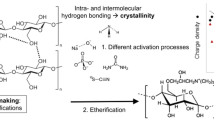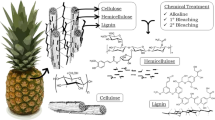Abstract
Bleached hardwood (HW) kraft pulp and derived nanocellulosic structures were modified by a periodate oxidation followed by treatment with sodium bisulfite to yield the corresponding C2/3 sulfonates. The impact of this oxidative–reductive protocol on the chemical and physical properties of cellulose was evaluated by determining physical dimensions, functional groups, and their water absorbency properties. It was found that the water absorbency of cellulosic material can be enhanced by 8.0–199.0% with this oxidation/sulfonation protocol. Distinct differences were observed between sulfonated pulp fibers and nanocellulosic structures, with the latter exhibiting relatively higher water retention values (WRV).



Similar content being viewed by others
References
Abdelmouleh M, Boufi S, Ben Salah A, Belgacem MN, Gandini A (2002) Interaction of silane coupling agents with cellulose. Langmuir 18(8):3203–3208
Calvini P, Conio G, Princi E, Vicini S, Pedemonte E (2006) Viscometric determination of dialdehyde content in periodate oxycellulose. Part II. Topochemistry of oxidation. Cellulose 13(5):571–579
Eichhorn SJ, Baillie CA, Zafeiropoulos N, Mwaikambo LY, Ansell MP, Dufresne A, Entwistle KM, Herrera-Franco PJ, Escamilla GC, Groom L, Hughes M, Hill C, Rials TG, Wild PM (2001) Current international research into cellulosic fibers and composites. J Mater Sci 36(9):2107–2131
Gurdag G, Guclu G, Ozgumus S (2001) Graft copolymerization of acrylic acid onto cellulose: effects of pretreatments and crosslinking agent. J Appl Polym Sci 80(12):2267–2272
Habibi Y, Chanzy H, Vignon MR (2006) TEMPO-mediated surface oxidation of cellulose whiskers. Cellulose 13(6):679–687
Huda MS, Drzal LT, Misra M, Mohanty AK (2006) Wood-fiber-reinforced poly(lactic acid) composites: evaluation of the physicomechanical and morphological properties. J Appl Polym Sci 102(5):4856–4869
Kim U, Kuga S (2002) Functionalization of cellulose by periodate oxidation. Cell Commun 9(2):69–75
Kim U, Shigenori K (1999) Modification of cellulose column packing by periodate oxidation. Chromatography 20(4):322–323
Kim U, Kuga S, Wada M, Okano T, Kondo T (2000) Periodate oxidation of crystalline. Cellulose 1(3):488–492
Kim U, Wada M, Kuga S (2004) Solubilization of dialdehyde cellulose by hot water. Carbohydr Polym 56(1):7–10
Klemm D, Heublein B, Fink H-P, Bohn A (2005) Cellulose: fascinating biopolymer and sustainable raw material. Angew Chem Int Ed 44(22):3358–3393
Kvien I, Tanem BS, Oksman K (2005) Characterization of cellulose whiskers and their nanocomposites by atomic force and electron microscopy. Biomacromolecules 6(6):3160–3165
Lloyd JA, Horne CW (1993) The determination of fiber charge and acidic groups of radiata pine pulps. Nord Pulp Paper Res J 8:48–52
Margutti S, Vicini S, Proietti N, Capitani D, Conio G, Pedemonte E, Segre AL (2002) Physical–chemical characterization of acrylic polymers grafted on cellulose. Polymer 43(23):6183–6194
Nelson K, Deng Y (2006) The shape dependence of core-shell and hollow titania nanoparticles on coating thickness during layer-by-layer and sol–gel synthesis. Nanotechnology 17:3219–3225
Pu Y, Zhang J, Elder T, Deng Y, Gatenholm P, Ragauskas AJ (2007) Investigation into nanocellulosics versus acacia reinforced acrylic films. Compos Part B-Eng 38(3):360–366
Pu Y, Ziemer C, Ragauskas AJ (2006) CP/MAS 13C NMR analysis of cellulase treated bleached softwood kraft pulp. Carbohyd Res 341(5):591–597
Ragauskas AJ, Williams CK, Davison BH, Britovsek G, Cairney J, Eckert CA, Frederick WJ Jr, Hallett JP, Leak DJ, Liotta CL, Mielenz JR, Murphy R, Templer R, Tschaplinski T (2006) The path forward for biofuels and biomaterials. Science 311(5760):484–489
Roman M, Winter WT (2006) Cellulose nanocrystals for thermoplastic reinforcement: effect of filler surface chemistry on composite properties. ACS Sympos Ser 938:99–113
Röhrling J, Potthast A, Rosenau T, Lange T, Borgards A, Sixta H, Kosma P (2002) A novel method for the determination of carbonyl groups in cellulosics by fluorescence labeling. 2. Validation and applications. Biomacromolecules 3(5):969–975
Saito T, Isogai A (2005) A novel method to improve wet strength of paper. Tappi J 4(3):3–8
Saito T, Okita Y, Nge TT, Sugiyama J, Isogai A (2006) TEMPO-mediated oxidation of native cellulose: microscopic analysis of fibrous fractions in the oxidized products. Carbohydr Polym 65(4):435–440
Saito T, Shibata I, Isogai A, Suguri N, Sumikawa N (2005) Distribution of carboxylate groups introduced into cotton linters by the TEMPO-mediated oxidation. Carbohydr Polym 61(4):414–419
Samir MASA, Alloin F, Dufresne A (2005) Review of recent research into cellulosic whiskers, their properties and their application in nanocomposite field. Biomacromolecules 6(2):612–626
Shet RT, Wallajapet PRR (1997) Manufacture of sulfonated cellulose with improved absorbent properties. US 5703225
Toriz G, Gatenholm P, Seiler BD, Tindall D (2005) Cellulose fiber-reinforced cellulose esters: biocomposite for the future. Nat Fibers Biopolym Biocompos 617–638
Varma AJ, Chavan VB, Rajimohanan PR, Ganapathy S (1997) Some observations on the high-resolution solid-state CP-MAS 13C NMR spectra of periodate-oxidised cellulose. Polym Degrad Stab 58:257–260
Wack H, Ulbricht M (2007) Method and model for the analysis of gel-blocking effects during the swelling of polymeric hydrogels. Ind Eng Chem Res 46(1):359–364
Waring MJ, Parsons D (2001) Physico-chemical characterization of carboxymethylated spun cellulose fibers. Biomaterials 22(9):903–912
Zhang J, Elder T, Pu Y, Ragauskas AJ (2007) Facile synthesis of spherical nanocellulose. Carbohyd Polym 69(3):607–611
Acknowledgments
We are grateful to KCC and NSF (EEC-0332554) for support of these studies. We also want to express our gratitude to K. Nelson and Dr. D.H. Kim from IPST@GA Tech for their valuable suggestions.
Author information
Authors and Affiliations
Corresponding author
Rights and permissions
About this article
Cite this article
Zhang, J., Jiang, N., Dang, Z. et al. Oxidation and sulfonation of cellulosics. Cellulose 15, 489–496 (2008). https://doi.org/10.1007/s10570-007-9193-1
Received:
Accepted:
Published:
Issue Date:
DOI: https://doi.org/10.1007/s10570-007-9193-1




